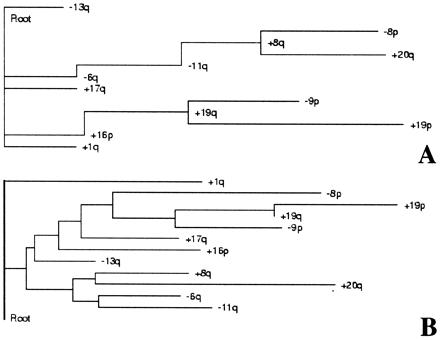Figure 1.

A schematic representation of results from the tree analysis of nonrandom genomic alterations of BRCAX breast carcinomas. The root represents a normal diploid mammary cell, whereas only events above the 95th percentile of the distribution are shown (see text for details). (A) Shown is how the observed probabilities of events and observed joint probabilities of pairs could be used to assign a weight to each possible “edge” between pairs and events. The edge represents a putative cause-and-effect relationship between events, whereas clusters of events may define a genetic subclass of tumors. (B) The result obtained from the best fitting distance matrix, weighted Fitch tree (see text for details). Both independent probabilistic approaches thus led to the following finding: The loss of chromosome 13 seems to be an early event in the pathogenesis of BRCAX breast cancers, and it is not strongly associated with other early or late events.
